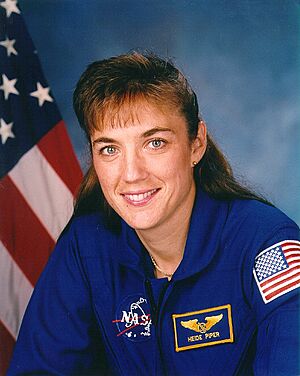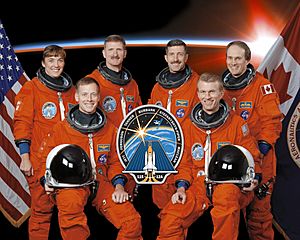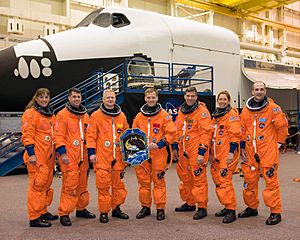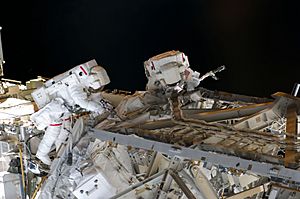Heidemarie Stefanyshyn-Piper facts for kids
Quick facts for kids
Heidemarie Stefanyshyn-Piper
|
|
|---|---|
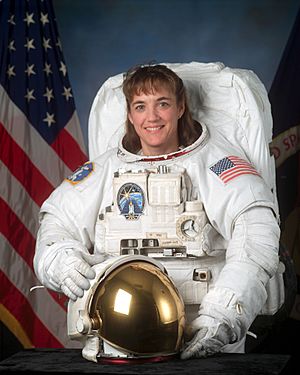
Stefanyshyn-Piper in 2003
|
|
| Born |
Heidemarie Martha Stefanyshyn
February 7, 1963 |
| Space career | |
| NASA astronaut | |
| Rank | Captain, USN |
|
Time in space
|
27d 15h 36m |
| Selection | NASA Group 16 (1996) |
|
Total EVAs
|
5 |
|
Total EVA time
|
33h 42m |
| Missions | STS-115 STS-126 |
|
Mission insignia
|
|
Heidemarie Stefanyshyn-Piper, born on February 7, 1963, is an amazing American Naval officer. She is also a former astronaut for NASA. She reached the high rank of Captain in the United States Navy.
Heidemarie was also an expert at marine salvage. This means she helped rescue ships that were in trouble. For example, she helped free the large oil tanker Exxon Houston when it got stuck near Hawaii. She also planned how to rescue a Peruvian submarine called Pacocha.
Heidemarie received many awards for her service. She flew on two Space Shuttle missions, STS-115 and STS-126. During these missions, she completed five spacewalks. These spacewalks added up to 33 hours and 42 minutes. This made her one of the top spacewalkers of all time.
Contents
Early Life and Education
Heidemarie Stefanyshyn-Piper was born in St. Paul, Minnesota, in the United States. Her family came from Ukraine. Her father, Michael, was born in a part of Ukraine that was once ruled by Poland. He was sent to work in Germany during World War II.
After the war, her father married a German woman. They both moved to the U.S. Heidemarie's mother, Adelheid, lived in St. Paul until she passed away in 2018. Heidemarie grew up in the Ukrainian community in Minneapolis–Saint Paul. She was a member of Plast, a Ukrainian scouting group, and she speaks Ukrainian.
Heidemarie graduated from Derham Hall High School in St. Paul in 1980. She earned two degrees from the Massachusetts Institute of Technology (MIT). She received a Bachelor of Science degree in 1984 and a Master of Science degree in 1985. Both of her degrees were in mechanical engineering. She is also a licensed ham radio operator.
Heidemarie married Glenn A. Piper, and they have one son. She added "Piper" to her last name after marriage. This was a way to remember her family roots.
Military Career Highlights
Heidemarie Stefanyshyn-Piper joined the Navy in June 1985. She completed special training to become a Navy Basic Diving Officer and Salvage Officer. During her time as a salvage officer, she helped free the tanker Exxon Houston when it got stuck off the coast of Hawaii.
By July 2009, Stefanyshyn-Piper had become a Captain in the United States Navy. She received many important awards during her military career. These awards recognized her excellent service and bravery.
NASA Astronaut Journey
NASA chose Heidemarie Stefanyshyn-Piper to be an astronaut candidate in April 1996. She started her training at the Johnson Space Center in August 1996. After two years of hard work and evaluation, she became a qualified mission specialist.
She first helped astronauts with launch and landing duties. Later, she became a lead representative for payloads. She also worked in the Astronaut Office's EVA branch. EVA stands for Extra-vehicular activity, which means spacewalks.
STS-115: Her First Space Mission
Heidemarie flew her first mission on STS-115. This mission was aboard the Space Shuttle Atlantis. It launched on September 9, 2006, and returned on September 21. She served as a mission specialist.
She became only the eighth woman to perform a spacewalk. She completed two spacewalks on this mission. These spacewalks lasted a total of 12 hours and 8 minutes. This made her the second most experienced female spacewalker at that time. She was also the first woman from Minnesota to go into space.
- Spacewalk One (5 hours, 26 minutes): With astronaut Joe Tanner, Heidemarie helped install a large part of the International Space Station's structure. They connected power cables and prepared the solar arrays for use.
- Spacewalk Three (6 hours, 42 minutes): Again with Joe Tanner, she installed a radiator. This radiator helped cool the new solar arrays. They also replaced a radio antenna and added insulation to another antenna.
After her mission, Heidemarie fainted twice during the welcome home ceremony. This is normal for astronauts as their bodies get used to Earth's gravity again.
NEEMO 12: Underwater Training

From May 7 to 18, 2007, Heidemarie Stefanyshyn-Piper commanded the 12th NEEMO expedition. NEEMO is a NASA program that studies how humans can survive in extreme environments. For this mission, they lived in the Aquarius underwater laboratory. This training helps prepare astronauts for future space exploration.
STS-126: Lead Spacewalker
Heidemarie flew as a mission specialist on STS-126. This mission was aboard the Space Shuttle Endeavour. It launched on November 14, 2008, and returned on November 30. She was the lead spacewalker for three of the four spacewalks on this mission.
The mission ended when Endeavour landed safely at Edwards Air Force Base, California. After her third spacewalk on STS-126, her total time spacewalking reached 33 hours and 42 minutes. This placed her among the top spacewalkers in history.
- Spacewalk One (6 hours, 52 minutes): With astronaut Stephen G. Bowen, Heidemarie moved an empty nitrogen tank. They also started cleaning and lubricating a large joint on the space station.
- Spacewalk Two (6 hours, 45 minutes): With astronaut Robert S. Kimbrough, she moved two equipment carts. They also continued cleaning and lubricating the station's robotic arm joint.
- Spacewalk Three (6 hours, 57 minutes): With Stephen G. Bowen, she finished cleaning and lubricating almost all the parts of the large joint.
The Lost Tool Bag
During her first spacewalk on STS-126, on November 18, 2008, something unexpected happened. As Heidemarie was getting ready to work, she saw a lot of grease in her tool bag. While cleaning it up, she accidentally pushed the bag away. The bag floated off into space.
The lost bag became space debris. It eventually burned up when it entered Earth's atmosphere on August 3, 2009. People on Earth could even see it with a telescope while it was in orbit.
Even though the bag was lost, the astronauts had all the tools they needed. Stephen Bowen had duplicates of the items in his bag. The main goals of the spacewalk were still completed. The estimated value of the lost equipment was about $100,000.
Heidemarie later said that watching the bag float away was "very disheartening." NASA officials explained that mistakes can happen when humans are working in space. They learn from these experiences to make future missions safer.
Retirement from NASA
In July 2009, Heidemarie Stefanyshyn-Piper retired from NASA's Astronaut Corps. She returned to her duties in the Navy.
Steven Lindsey, who was the Chief of the Astronaut Office at the time, praised her. He said she was an "outstanding astronaut" and helped a lot with the Space Shuttle and Space Station programs. He especially noted her great leadership during the STS-126 mission. She helped restore full power to the International Space Station.
Heidemarie received two NASA Space Flight Medals and the NASA Exceptional Service Medal. In August 2009, she started working at the Naval Sea Systems Command as the chief technology officer.
On May 20, 2011, Captain Stefanyshyn-Piper became the commander of the Carderock Division of the Naval Surface Warfare Center in Maryland.
Heidemarie Stefanyshyn-Piper retired from the U.S. Navy on July 1, 2015. She had served her country for 30 years on active duty.
See also
 In Spanish: Heidemarie Stefanyshyn-Piper para niños
In Spanish: Heidemarie Stefanyshyn-Piper para niños


